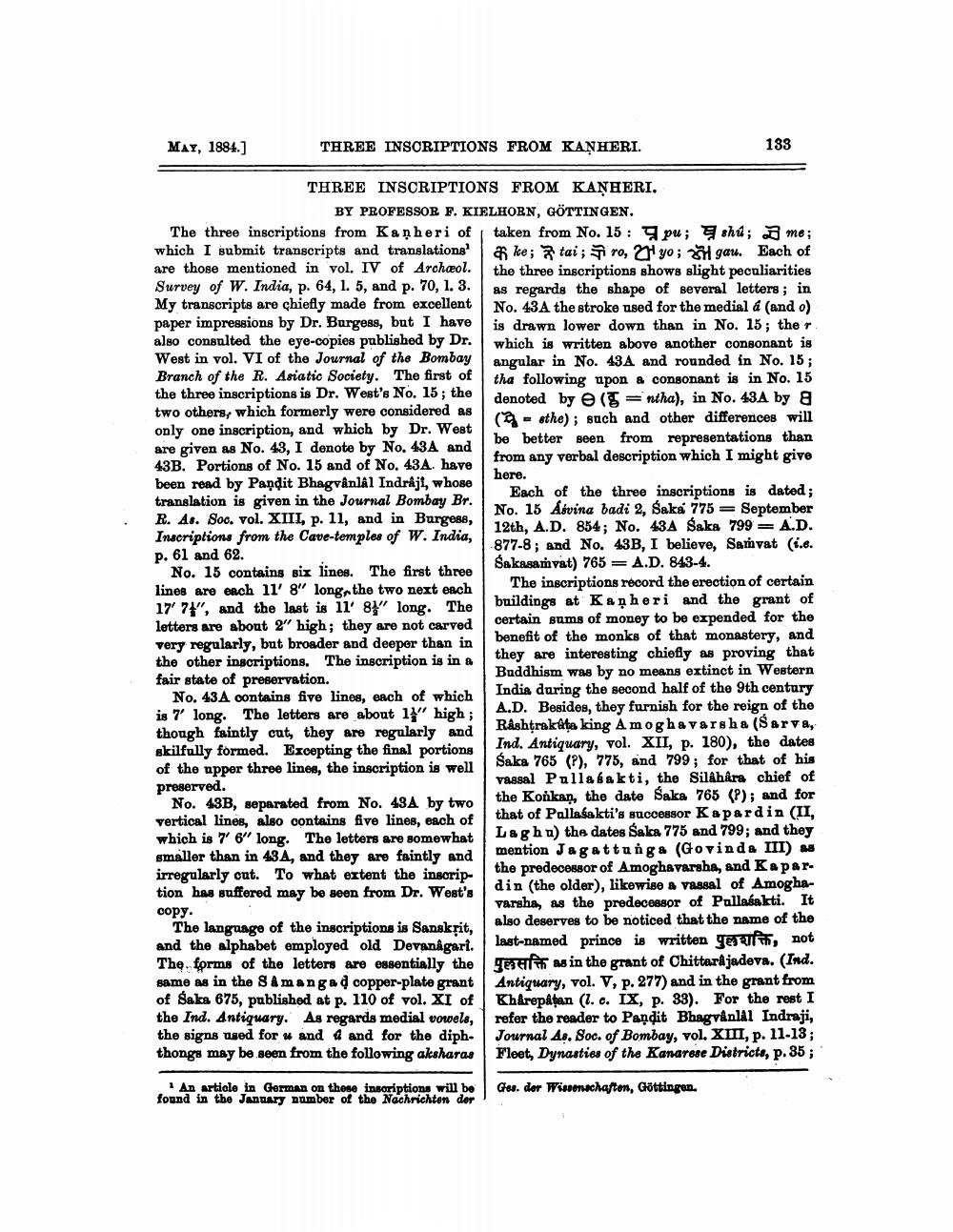________________
MAY, 1884.]
THREE INSCRIPTIONS FROM KANHERI.
133
THREE INSCRIPTIONS FROM KAŅHERI.
BY PROFESSOR F. KIELHORN, GÖTTINGEN. The three inscriptions from Kaņheri of taken from No. 15: pu; shu; B me; which I submit transcripts and translations' ke; tai; ro, 'yo; gau. Each of are those mentioned in vol. IV of Archæol. the three inscriptions shows slight peculiarities Survey of W. India, p. 64, 1. 5, and p. 70, 1. 3. as regards the shape of several letters; in My transcripts are chiefly made from excellent No. 43A the stroke used for the medial & (and o) paper impressions by Dr. Burgess, but I have
is drawn lower down than in No. 15; the also consulted the eye-copies published by Dr. which is written above another consonant is West in vol. VI of the Journal of the Bombay
angular in No. 43A and rounded in No. 15; Branch of the R. Asiatic Society. The first of
tha following upon a consonant is in No. 15 the three inscriptions is Dr. West's No. 15; the
denoted by e(=ntha), in No. 43A by a two others, which formerly were considered as
(-sthe); such and other differences will only one inscription, and which by Dr. West are given as No. 43, I denote by No. 43A and
be better seen from representations than 43B. Portions of No. 15 and of No. 43A. have
from any verbal description which I might give
here. been read by Pandit Bhagvanlal Indraji, whose
Each of the three inscriptions is dated; translation is given in the Journal Bombay Br.
No. 15 Abvina badi 2, Saka 775 = September R. As. Soc. vol. XIII, p. 11, and in Burgess,
12th, A.D. 854; No. 43A Saka 799 = A.D. Inscriptions from the Cave-temples of W. India,
877-8; and No. 43B, I believe, Samvat (i.e. p. 61 and 62.
Sakasamvat) 765 = A.D. 843-4. No. 15 contains six lines. The first three lines are ench 11' 8" long, the two next each
The inscriptions record the erection of certain 17' 7", and the last is 11' 8" long. The
buildings at Kaheri and the grant of letters are about 2'' high; they are not carved
certain sums of money to be expended for the very regularly, but broader and deeper than in
benefit of the monks of that monastery, and the other inscriptions. The inscription is in a
they are interesting chiefly as proving that fair state of preservation.
Buddhism was by no means extinct in Western No. 43A contains five lines, each of which
India during the second half of the 9th century is 7' long. The letters are about 1 high ;
A.D. Besides, they furnish for the reign of the though faintly cut, they are regularly and
Rashtrakata king Amoghavarsha ($arva, skilfully formed. Excepting the final portions
Ind. Antiquary, vol. XII, p. 180), the dates of the upper three lines, the inscription is well
Saka 765 (P), 775, and 799; for that of his
Vassal Pullabakti, the SilAhara chief of preserved. No. 43B, separated from No. 43A by two
the Konkan, the date Saka 765 (P); and for vertical lines, also contains five lines, each of
that of Pallaśakti's successor Kapardin (II, which is 7 6'' long. The letters are somewhat
Laghu) the dates Saka 775 and 799; and they smaller than in 43A, and they are faintly and
mention Jagattunga (Govinda III) - irregularly out. To what extent the inscrip
the predecessor of Amoghavarsha, and Kapartion has suffered may be seen from Dr. West's
din (the older), likewise a Vassal of Amoghacopy.
Varsha, as the predecessor of Pallasakti. It The language of the inscriptions is Sanskrit,
also deserves to be noticed that the name of the and the alphabet employed old Devanagari.
last-named prince is written Teh, not The forms of the letters are essentially the TEH as in the grant of Chittardjadeva. (Ind. same as in the Samangad copper-plato grant | Antiquary, vol. V, p. 277) and in the grant from of Saka 675, published at p. 110 of vol. XI of Kh&repatan (I. c. IX, p. 33). For the rest I the Ind. Antiquary. As regards medial vowels, refer the reader to Pandit Bhagvanlal Indraji, the signs used for # and a and for the diph- Journal As. Soc. of Bombay, vol. XIII, p. 11-13; thongs may be seen from the following aksharas Fleet, Dynasties of the Kanarese Districts, p. 35;
* An article in German on these insoriptions will be found in the January number of the Nachrichten der
Gos. der Wissenschaften, Göttingen.




